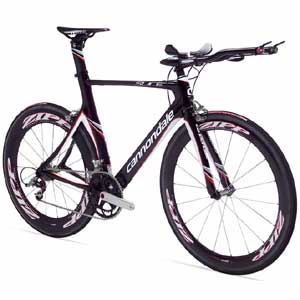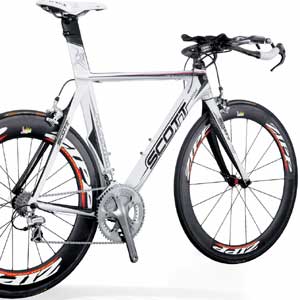Felt’s tri bikes for 2008
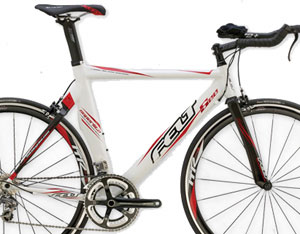
If you were to chart the functionality of Felt's tri bikes over recent years, the arc would show a steady rise through 2005, a dip the next year, followed by a steep ascent in 07 and a continued rise in 08.
Prior to 2006 Felt's DA was essentially a road geometry bike, and it's S32 and S22 were bikes that had numerous, but complementary, problems. They fit badly because the seat angles were too shallow, the top tubes too long, and the head tubes too short. But if you pitched the saddle forward a bit via an aftermarket seat post, this both steepened the seat angle and shortened the virtual top tube. This made the short head tubes more acceptable, and all three of these mistakes caused the bikes to work because they were the "right" mistakes if made in concert with each other.
Then in 2006 Felt introduced some sexy features in its bikes that remain on its S22 today today, such as its aero seat stays and machined head tube. Also included was an aero seat post that slid nicely into a correspondingly shaped seat tube. Nice feature, yes, but this exposed the ill-considered geometry. Now riders were nailed back to those 76 degree seat angles which were, in fact, closer to 75 degrees because of this seat post clamp's slight setback from centerline.
You could no longer "fix" the overlong top tube by sliding in a Thompson dog-leg seat post flipped forward, and the head tubes were impossibly short. I remember the Felt booth at Interbike, prior to the 2006 model year, with a complete S22 hanging suspended in mid-air, showing off a nice, appropriate armrest drop from saddle — and 5 centimeters of spacers under the stem.
Fortunately, Felt was able to limp along through 2006 knowing that it would unveil a complete, top-to-bottom change that September. When the new and improved Felt DA was debuted at Interbike, all eyes went to its lines. The Bayonet fork and submerged rear brake caliper were show stoppers.
More interesting to me was its S22 (pictured above), which to the naked eye looked exactly as it did the prior year. But it was a very different bike. All of Felt's geometries were updated for 2007. The geometries exhibited in the DA and B2 flowed all the way down to the S32. In short, the 2006 bikes did not work at all. These 07 bikes worked wonderfully. Which brings us to present.
GEOMETRIES
Last week I heard a presentation by Steve Hed, founder and owner of Hed Cycling, and notably the fitter to Levi Leipheimer, Vladimir Guseve, Jani Brajkovic and others. He addressed a room packed full of eager listeners, one of whom asked, "What are the most important aerodynamic elements to consider when fitting someone?"
"Position," Hed replied. "That's above all the rest." Then Hed continued down the list of front wheel, helmet, fork, frame, rear wheel and so on, in their proper order. A rider's position is paramount to his aerodynamics and, of course, of all the aerodynamic elements to be considered, it's the one thing that impacts a rider's power. That's why Felt's most important change in 07 was not the sexy frame features it introduced, but the geometric changes that flowed throughout its line.
This is not to say that Felt's bikes fit everyone. No company's bikes fit everyone. But Felt's bikes are designed to fit the fat of the bell curve of triathletes. Every bike has a "posture," and Felt's posture is steep, but not ridiculously so, and low in front, but not ridiculously so. Draw a centerline from the bottom bracket through the rails of the saddle when the Felt is at its best, that seat angle is about 79 degrees.
That's very steep, you might say. Not so. In point of fact, among today's top triathletes 90 percent of them ride at 77 degrees or steeper. Many ride at 81 or 82 degrees. Seventy-nine degrees is about average. And by "top" triathletes I'm including not simply pros but the better age group racers.
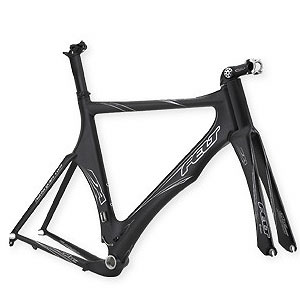
This presents a conundrum for Felt customers. The single-position post that comes standard on Felt's tri bikes often doesn't accommodate one's optimized fit coordinates. It's too shallow for some, and it's too short for others. But Felt makes a nifty (and longer) two-position post. The forward of the two positions represents the way this bike ought to be ridden. If you own one of these bikes, and you're riding with your saddle in the rearward of the two seat post positions, march yourself in for a reposition.
About that two-position post. I'm told it slides into the seat tube of the old 06 S22. If you've got one of these bikes, buy this post (it's available aftermarket at Felt retailers) and you'll solve what I feel is this bike's achilles heel. If you're interested in one of Felt's fine 2008 models, I'd not leave without the two position post installed on my bike. Make that a prerequisite to purchase, unless you know that the single position post works for you.
One final note about the geometries in Felt's lineup. Tri bike companies that have abandoned 650c wheels on bikes in the smallest sizes have seen customers abandon their brands. All the sales of tri bikes below 50 centimeters have flowed to Felt, Cervelo, Kestrel, QR, Elite, Calfee and other companies that make their smallest sizes with 650c wheels. Felt makes its smallest two sizes with 650c, and the bikes are marvelous.
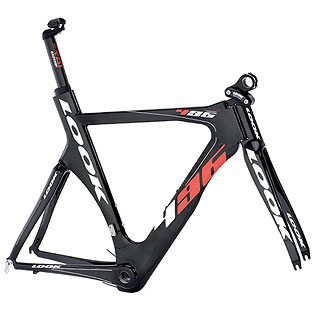
DA
The styling of the Felt DA (frameset pictured above) borrows heavily from the Look 496 (picture adjacent). Parallels between the down tube and seat tube are unmistakable, as is the fork styling and adjustable stem.
But there are significant differences. While the 496 is built with a 74.5 degree seat angle (nominally 76 degree with factory forward facing seat post), the Felt's seat angle using its post's forward position is, as stated, closer to 79 degrees. When using current best practices — which calls for a rider's fit coordinates to be established on a simulator and those coordinates matched to available production bikes — the Felts are quite often identified as workable options for the customer.
In other words, riders do not need to alter their positions to the bike. Felt has altered its bikes' positions to match their customers.
Felt's flagship, the DA, incorporates the Bayonet fork. This style appears like that which Look calls a Monoblade and which it pioneered more than a decade ago. There are some differences, one of which is the ability to swap this fork out for a standard fork.
The Bayonet is a fork and stem all in one. There are three extension lengths included with the bike, and the lengths are one centimeter apart in length (there are four lengths available in total, from 8cm to 11cm). The extensions are height adjustable, and they are fixed in position by a spline system that acts as a keyway. Reports from the field say to grease the splines, and blue loctite the bolt that affixes the spline halves in place. I'm also told that the 08 Bayonets have a different fixing bolt that prevents movement in the spline assembly.
Cables and housing are inside the frame, including that rear brake cable that runs down the down tube to the caliper positioned just behind the bottom bracket. This caliper positioning could've been a nightmare, but Felt was slick in its engineering, and the cables route easily. Keep in mind that the shift housing chosen by Felt is 4mm in diameter, and that's required. the 5mm housing I often use won't fit inside this frame. The reason the spec is so tight are sets of O-rings that keep moisture out of the frame.
The DA complete costs $9500 spec'd full-race soup to nuts, and my word that's a lot of money. Thankfully, they've given you a $6500 option if you'd like to buy the bike without the Zipp rear disc and front 999.
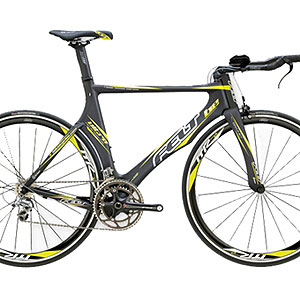
Still, I'd consider building this frame up with my own parts. I don't know that Zipp's Vuka, while featuring probably the most ergonomic (for pursuit position riding) integrated pursuit bar going, has armrests and extensions that will please all riders. And the Dura Ace kit, while extra nice, has inferior shift levers to SRAM, and Zipp's Vuka levers are probably a step down from those SRAM makes.
The frame, fork, stem and seat post cost $3500, and for the other $3000 I think I might be able to spec a bike a bit more to my liking.
B2 PRO
This $6000 complete bike features Zipp 404 wheels and a Dura Ace kit. I'd consider this a nice value were it not for the B2 just below it.
B2
This (pictured above) is the sweet spot in Felt's tri bike line. You get Dura Ace where it matters (derailleurs) and not in the consumables (chain, cassette), which will wear out eventually and then you'll have to change them, probably to something cheaper. You get a high end FSA carbon crank and the same aerobars as you do on the next bike up. But this bike costs $3500 complete. You'll probably swap out the saddle, and you might swap the aerobars out for something more ergonomic than FSA's S-bend (even if it's FSA's R-bend).
B12
When a competitive bike company goes for the jugular, this is the sort of bike they put out. It sells for $2700, with a frame that pops out of the same mold as it's $9500 model. You don't get the Bayonet fork, but, what the hey. Here's the thing to keep in mind: at this price point and down, Felts start to come with Profile Design bars. No problem there. But the Profiles feature armrests that sit about 3cm higher than the armrests sit on Vision bars. So, the B12, S22 and S32 are going to fit differently than the B2 and above.
S22
This $2000 bike was $2500 just a whisper ago, and that tells you what happens when the new models make the old models obsolete. This is a much better bike than it was a couple of years ago, or at any time before that. Five years ago Felt didn't make a bike at any price as fine as this one.
S32
This is the quintessential entry level bike. Felt almost owns this category, and would were it not for a spirited rivalry with QR and Cervelo at the mid-teens price point.



